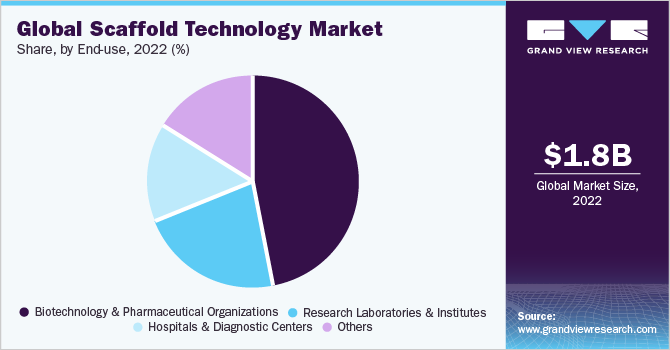Scaffold Technology Market To Grow As Of Rising Demand For 3D Cellular Models In Biological Studies And Translational Research

Scaffold Technology Industry Overview
The global scaffold technology market size is expected to reach USD 2.1 billion by 2028, according to a new report by Grand View Research, Inc. The market is expected to expand at a CAGR of 8.4% from 2021 to 2028. The market growth can be primarily attributed to the growing popularity of bioprinting for mimicking the tissue microenvironment in printed 3D tissue models. The need to expand the horizon of multidisciplinary research areas has supplemented the adoption of scaffold technologies in 3D printed models.
Scaffold Technology Market Segmentation
Grand View Research has segmented the global scaffold technology market based on type, application, disease type, end-use, and region:
Based on the Type Insights, the market is segmented into Hydrogels, Wound Healing, 3D Bioprinting, Immunomodulation.
- The hydrogels emerged as a dominant segment and accounted for the largest revenue share of 42.2% in 2020. Ongoing technological advancements in the microfabrication of hydrogels are expected to boost segment growth in the near future.
- The nanofiber-based scaffolds segment is anticipated to witness a lucrative CAGR of 9.8% over the forecast period. The rising adoption of nanofiber-based scaffolds in tissue engineering and regeneration applications is primarily contributing to the segment growth.
- The enhanced nanofibrous scaffolds are modified using wet chemistry (covalent) or mineralization that can efficiently mimic native bone tissue. In addition, the study also concluded that these scaffolds can also be used for the sustained release of growth factors.
Based on the Application Insights, the market is segmented into Stem Cell Therapy, Regenerative Medicine, & Tissue Engineering, Drug Discovery, Others.
- The stem cell therapy, regenerative medicine, and tissue engineering segment dominated the market for scaffold technology and accounted for the largest revenue share of more than 66.0% in 2020.
- The growth is attributed to the growing implementation of scaffold technology for reconstruction surgeries, aesthetic surgeries, soft tissue tumor repair, abdominal wall repair, periodontology, and colorectal surgeries.
- The drug discovery segment is expected to witness substantial growth during the forecast period. The need to develop robust and portable tools in the field of biomedical science, including drug discovery and therapeutic development, has driven the demand for scaffold technology in this segment.
Based on the Disease Type Insights, the market is segmented into Orthopedics, Musculoskeletal, & Spine, Cancer, Skin & Integumentary, Dental, Cardiology & Vascular, Neurology, Urology, GI, Gynecology, Others.
- The orthopedics, musculoskeletal, and spine segment dominated the market for scaffold technology and accounted for the largest revenue share of more than 50.0% in 2020. It is estimated that nearly 34.0 million surgeries on the musculoskeletal system are performed in the United States annually.
- The neurology segment is expected to witness the fastest CAGR from 2021 to 2028 due to the high adoption of stem cell therapy and regenerative medicine for the treatment of neurodegenerative disorders.
- For instance, in January 2021, researchers developed a bioactive scaffold based on immobilized nerve growth factor (NGF) containing polycaprolactone/chitosan (PCL/CS) nanofibers for supporting nerve regeneration.
Based on the End-use Insights, the market is segmented into Biotechnology and Pharmaceutical Industries, Research Laboratories and Institutes, Hospitals and Diagnostic Centers, Others.
- The biotechnology and pharmaceutical industries segment dominated the market for scaffold technology and accounted for the largest revenue share of 46.7% in 2020.
- The growth in the segment is due to the extensive application of scaffold technology by these industries in tissue engineering fields including periodontal regeneration, cartilage development, bone formation, repair of nasal and auricular malformations, tendon repair, and heart valves.
- For instance, in November 2020, the U.K. biotechnology companies including Manchester BIOGEL and Cellesce developed three-dimensional (3D) scaffolds that can accurately mimic the physiological environment, enabling the manufacturing and scale-up of patient-derived organoids.
- The hospitals and diagnostic centers segment are expected to witness a lucrative CAGR of 8.8% over the forecast period. The growth in the segment is owing to an increase in the number of grafting procedures and an increase in cases of road accidents and related injuries, all of which create a greater demand for biological scaffolds.
Scaffold Technology Regional Outlook
- North America
- Europe
- Asia Pacific
- Latin America
- Middle East & Africa (MEA)
Key Companies Profile & Market Share Insights
The rising initiatives for promoting products based on scaffold technology are contributing to the growth of the market for scaffold technology. For instance, in January 2021, UnitedHealthcare expanded its medical policies for Vericel Corporation’s MACI (autologous cultured chondrocytes on porcine collagen membrane) for including coverage for individuals with multiple cartilage defects in the knee and cartilage defects in the patella.
Some prominent players in the global scaffold technology market include
- Thermo Fisher Scientific, Inc.
- Merck KGaA
- Tecan Trading AG
- REPROCELL Inc.
- 3D Biotek LLC
- Becton, Dickinson, and Company
- Medtronic
- Xanofi
- Molecular Matrix, Inc.
- Matricel GmbH
- Pelobiotech
- 4titude
- Corning Incorporated
- Akron Biotech
- Bioquote Ltd
- Avacta Life Sciences Limited.
- Nanofiber Solutions
- Vericel Corporation
- NuVasive, Inc.
- Allergan
Order a free sample PDF of the Scaffold Technology Market Intelligence Study, published by Grand View Research.
Comments
Post a Comment